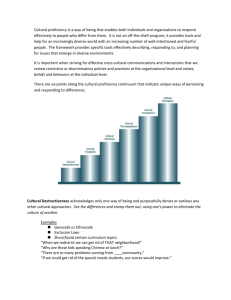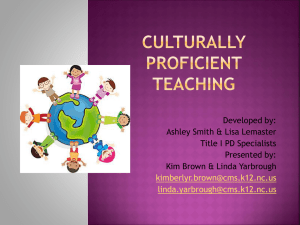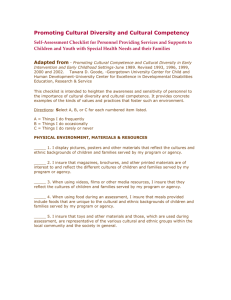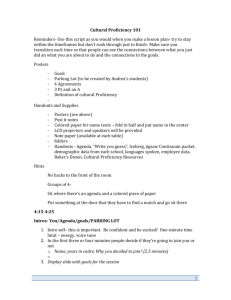Cultural Proficiency - Montgomery County Schools
advertisement
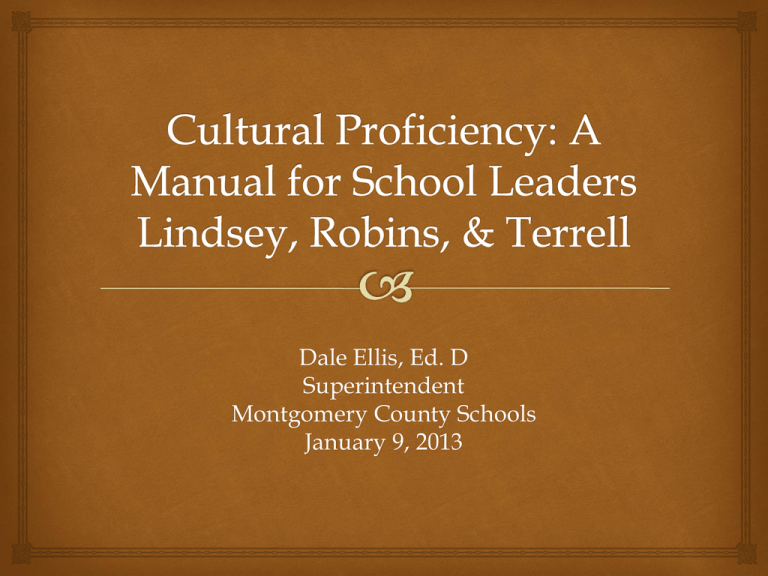
Dale Ellis, Ed. D Superintendent Montgomery County Schools January 9, 2013 Chapter 1: Cultural Proficiency Cultural Proficiency is a mind-set, a worldview, a way a person or an organization make assumptions for effectively describing, responding to, and planning for issues that arise in diverse environments. The Four Tools The Barriers The Guiding Principals The Continuum The Essential Elements The Barriers The presumption of entitlement and privilege makes some people blind to barriers experienced by others. Systems of oppression and privilege are forces that affect some individuals based upon membership in a distinct cultural group. Unawareness of the need to adapt is a type of resistance to change where some individuals believe other groups need to change to adapt to the dominant group. The Guiding Principals Culture is a predominant force…You can’t not have a culture. People are served in varying degrees by the dominant culture. Group identity of individuals is as important as individual identities. Diversity within cultures is vast and significant. Each group has unique cultural needs. The family, as defined within the culture, is the predominant force in a child’s education. The Guiding PrincipalsCont.’ Marginalized populations have to be at least bicultural, which creates unique issues. Cross-cultural interactions are dynamic and must be acknowledged, adjusted to, and accepted. The school system must incorporate cultural knowledge into practice and policy making. The Continuum Cultural Destructiveness – Seeks to eliminate cultures within the school. Cultural Incapacity – Trivializing and stereotyping other cultures….making others inferior to the dominant group. Cultural blindness – Not noticing or acknowledging other cultures and being blind to the need for differentiation. The Continuum – Cont.’ Cultural Precompetence – Increasing awareness of what you and the school don’t know about working in diverse settings. Can move forward or regress from here. Cultural Competence – Inclusive of different views in such a way that healthy and positive interactions can take place. Cultural Proficiency – Holding the vision that you and the school are instruments for creating a socially-just democracy; interacting with your colleagues, your students, their families, and their communities as an advocate for lifelong learning to serve effectively the educational needs of all cultural groups. The Essential Elements Assess Culture – Identify the differences Value Diversity – Embrace the differences Manage Difference – Reframe the differences so it is not viewed as a problem to be solved Adapt to Diversity – Teach and learn the differences so you can respond effectively Institutionalize Cultural Knowledge – Change systems to ensure healthy and effective responses A Historical Context Pre-1950’s – Segregation 1950’s – Desegregation 1960’s – Integration, equal access, equal rights 1970’s – Equal benefits, multiculturalism 1980’s – Diversity 1990’s – Cultural Competence 2000’s – Cultural Proficiency Table Time In what decade do you feel your faculty members reside? Discuss your findings on the question above in light of “The Culturally Proficient Professional” on page 21. Is there no gap, a mud puddle, or a crevice? Chapter 2 – A Cultural and Historical Context for Our Unfolding Democracy An inside-out approach = those external of the school are relieved of the responsibility of adaptation. Requirements include an informed and dedicated faculty/staff, committed and involved leadership, and time. Important Points to Remember A culture is a group of people identified by their shared history, values, and patterns of behavior. When thinking of culture, most think of ethnic culture associated with people who are different from them. Social cultures are groups of people who share a common interest. Occupational cultures involve groups who share a vocation. Organizational culture is shared by all who work for the school system The “Legacy” (pp.29-41) Segregation Exclusion Immigrant/Caste systems Social Darwinism Eugenics Racism Sexism Heterosexism Ch. 3 – Leadership for Today’s Schools Principals working in a transactional world are expected to produce transformational changes - Lindsey, Daly, & Ibarra (2009, p.7) Transformational Leadership Idealized Influence – You’ve got to stand for something or you’ll fall for anything. Inspirational Motivation – I believe I can fly… Intellectual Stimulation – Change is good. Individualized Consideration – How may I help you? Key Leadership Characteristics Taking responsibility for one’s own learning. Having a vision for what the school can be. Effectively sharing that vision with others. Assessing one’s own assumptions and beliefs. Understanding the structural and organic nature of schools. How can you use this knowledge to advance cultural proficiency in YOUR school? Collaborative Leadership In your words, what does this look like at your school? Take 2 minutes with a neighbor. The Culturally Proficient Leader You must be able to identify issues of class, caste, culture, and gender. You must develop a vision and a mission that serves the needs of all students. You must guide others in challenging assumptions and translating perspectives, perceptions, values, and goals into agendas for school change. You must be able to support and lead school personnel in formulating plans for school change. Case 1 In a SIT discussion, a teacher exclaims, “I am having the hardest time reaching these kids. These kids can’t learn!” Discuss how you would handle with your neighbor in 2-3 minutes. Case 2 A parent wants to meet with you. After the discussion, you confirm through witnesses that a teacher made a derogatory statement in class about a student. The student is perceived as gay by students and staff although the student has neither confirmed nor denied it. The teacher’s statement was in relation to the student’s sexual orientation. Discuss how you would handle with your neighbor in 2-3 minutes. Case 3 In reviewing class discipline, you notice that a teacher had 15 referrals last month. Fourteen of the referrals were for African American males. African American males make up just 10 percent of the teacher’s class list. Discuss how you would handle with your neighbor in 2-3 minutes. Review Activity Review pp. 55-56 Answer the “Going Deeper” questions on page 56 in the reflection area. The depth at which you take this with your faculty is up to you, based upon school need. We will study the entire book and you can use the salient tools as you see necessary. Be prepared to discuss next steps at your 3rd quarter coaching session.

